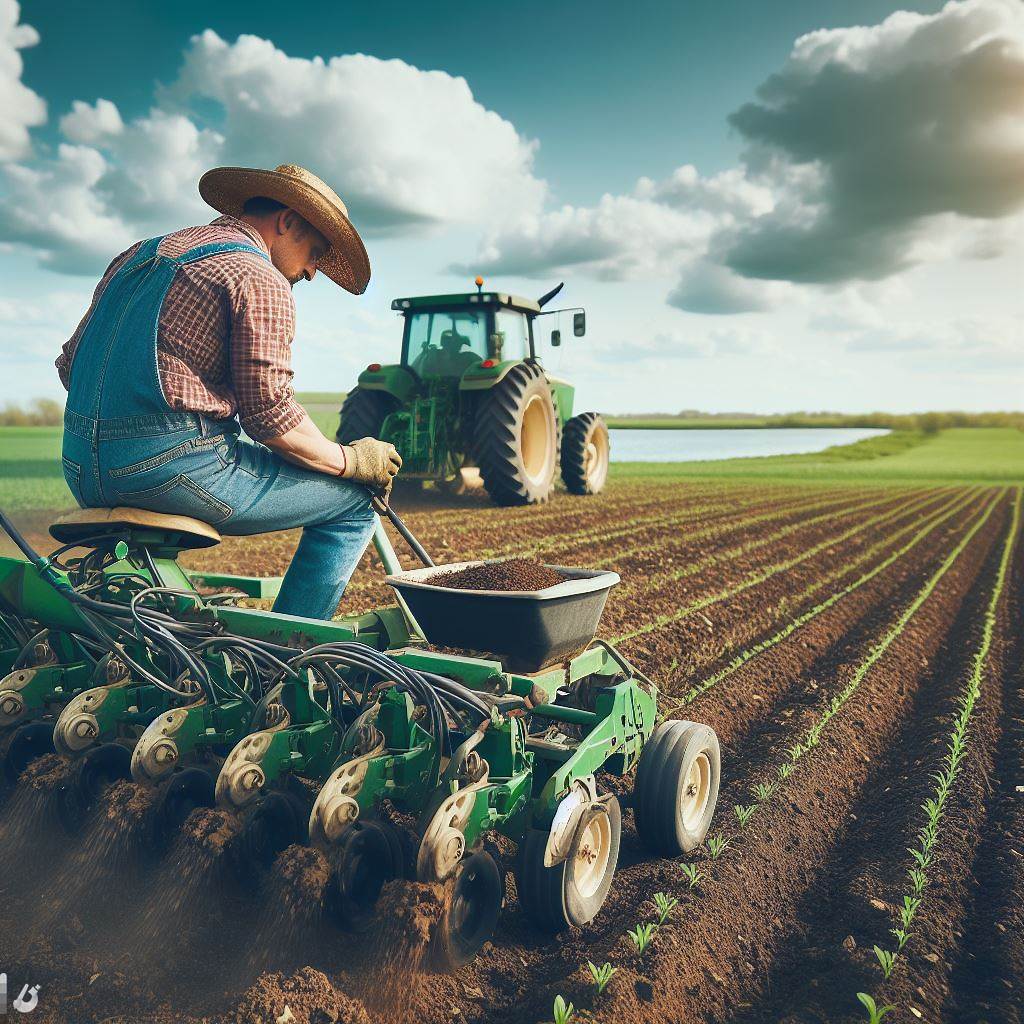Introduction
Investing in agriculture is not only about growing food, but also about securing a sustainable future.
Agriculture is the backbone of our society, providing food, jobs, and economic stability.
Farmers and agricultural businesses need adequate investment to ensure a continuous supply of food and to expand their operations.
The purpose of this blog post is to provide useful tips for individuals who are considering investing in the agricultural sector.
Whether you are a beginner or an experienced investor, these tips will help you make informed decisions and maximize your returns.
- Understand the market: Conduct thorough research on the current trends, demand, and potential risks in the agricultural sector. Stay updated with the latest technologies and innovations.
- Diversify your investments: Invest in various agricultural sectors such as crops, livestock, or agro-processing to minimize risks and maximize returns.
- Invest in sustainable practices: Support environmentally-friendly agricultural practices to ensure long-term profitability and reduce negative impacts on the ecosystem.
- Collaborate with experienced professionals: Build a network of experts, such as agronomists, economists, and financial advisors, who can provide valuable insights and guidance.
- Monitor policy changes: Stay informed about government policies, subsidies, and regulations that may impact the agricultural sector to make smart investment decisions.
- Evaluate risks and returns: Assess the financial risks involved in agriculture, such as weather conditions, market fluctuations, and disease outbreaks, along with projected returns on investment.
- Explore technological advancements: Embrace modern technologies like precision farming, automation, and data analytics to improve productivity and efficiency in agriculture.
Investing in agriculture has the potential to not only generate financial returns, but also contribute to food security and sustainable development.
By following these investment tips, you can make a positive impact while achieving your financial goals.
Overview of the agricultural industry
Agriculture is an essential industry that plays a significant role in the global economy.
It involves the cultivation of crops, raising livestock, and the production of food, fiber, and other agricultural products.
Statistics and growth trends
- The agricultural industry is responsible for feeding the world’s population, which is estimated to reach 9.7 billion by 2050.
- In 2020, the global agricultural market was valued at $7.3 trillion, and it is expected to grow at a CAGR of 3.5% from 2021 to 2028.
- The United States is the largest agricultural exporter, with countries like China, Canada, and Mexico as its top trading partners.
- Technological advancements, such as precision farming and automation, have revolutionized the industry and improved productivity.
- Sustainable agriculture practices have gained momentum to minimize environmental impact and ensure long-term viability.
Potential benefits and risks
Investing in agriculture can provide various benefits, including stable returns, diversification of investment portfolio, and potential tax advantages.
Agricultural investments are often considered a hedge against inflation due to the constant demand for food and other agricultural commodities.
Opportunities exist for investors to support sustainable agricultural practices, contributing to environmental conservation and social responsibility.
However, the agricultural industry is not without risks. It is susceptible to unpredictable weather patterns, pests, diseases, and price volatility.
Investors need to consider factors such as land quality, government policies, market demand, and access to financing before making investment decisions.
Overall, the agricultural industry presents numerous investment opportunities for individuals and institutions.
Transform Your Agribusiness
Unlock your farm's potential with expert advice tailored to your needs. Get actionable steps that drive real results.
Get StartedAs the global population continues to grow, the demand for food and agricultural products will continue to rise.
Investing in agriculture can be a profitable venture while also contributing to food security and sustainable development.
Types of agricultural investments
In agriculture, there are various types of investments that individuals can consider:
Farmland acquisition
When investing in farmland, there are several factors that need to be taken into account:
- Location, fertility, size, and access to water sources are important considerations.
- Investing in farmland provides benefits such as diversification and potential long-term capital appreciation.
- Challenges include high upfront costs, management requirements, and vulnerability to natural disasters.
Agribusiness ventures
Investing in agribusiness ventures offers different examples and opportunities:
- Examples include organic farming, aquaculture, livestock production, and agricultural technology.
- Potential returns can be high, especially with innovative and sustainable agricultural practices.
- Risks include market fluctuations, regulatory changes, and competition within the industry.
Agricultural commodities
Investing in agricultural commodities can be a lucrative option for investors:
- Agricultural commodities refer to raw materials such as grains, livestock, and coffee.
- Investing in agricultural commodities provides potential benefits like hedging against inflation.
- Market factors to consider when investing in commodities include supply and demand, weather patterns, and geopolitical factors.
Overall, these types of agricultural investments offer different opportunities and considerations for investors.
It’s important to thoroughly research and understand the specific investment before committing any funds.
Read: Export Strategies for Farmers
Factors influencing agricultural investments
Investing in agriculture requires careful consideration of various factors that influence the performance and profitability of agricultural investments.
These factors can be broadly categorized into market conditions and technological advancements.
Market conditions
When considering agricultural investments, it is crucial to analyze the prevailing market conditions.
Supply and demand dynamics dictate the profitability and sustainability of agricultural ventures.
Understanding the balance between supply and demand for specific agricultural products can help investors identify potential opportunities.
Price fluctuations and forecasts are another critical aspect of market conditions.
Agricultural commodity prices can exhibit significant volatility, impacting the profitability of investments.
Monitoring price trends and forecasts can assist investors in making informed decisions about the timing of their investments.
Technological advancements
The agricultural sector has witnessed significant technological advancements in recent years.
These advancements have had a profound impact on productivity and efficiency, making them an essential consideration for agricultural investors.
New technologies, such as precision farming techniques, have revolutionized agricultural practices.
They enable farmers to optimize resource allocation, reduce waste, and increase yields.
These technological advancements enhance the overall profitability and sustainability of agricultural investments.
Innovation and future prospects are crucial factors that attract investors towards agricultural investments.
Research and development in the agricultural sector continuously introduce new technologies and practices, offering promising future prospects.
Showcase Your Farming Business
Publish your professional farming services profile on our blog for a one-time fee of $200 and reach a dedicated audience of farmers and agribusiness owners.
Publish Your ProfileInvestors who recognize the potential of these innovations often seek opportunities in the agricultural sector.
Moreover, technological advancements also address environmental concerns associated with traditional agriculture.
Sustainable agricultural practices, supported by technology, reduce the negative impact on the environment.
This alignment with sustainability goals enhances the appeal of agricultural investments to environmentally-conscious investors.
In general, when considering agricultural investments, it is essential to analyze both market conditions and technological advancements.
Market conditions, including supply and demand dynamics, as well as price fluctuations and forecasts, provide insights into profitability and timing.
Technological advancements, on the other hand, influence productivity, efficiency, and future prospects.
Incorporating these factors into investment decisions can help investors maximize their returns and contribute to sustainable agricultural practices.
Read: Climate Change and Agribusiness

Risk management strategies
Investing in agriculture can be profitable, but it also involves risks.
To ensure a successful investment, it is crucial to employ effective risk management strategies.
In this section, we will discuss the various risk management strategies that can be adopted in the agricultural sector.
Diversification of investments
Spreading risks across different sectors
One effective strategy to manage risk is to diversify investments across different sectors within the agriculture industry.
Investing in various sectors, such as crops, livestock, or fisheries, helps spread the risks associated with market fluctuations and unforeseen events.
For example, if there is a decline in the price of a particular crop, the overall impact on the investment portfolio can be minimized if investments are spread across multiple sectors.
Balancing between high and low-risk investments
Another approach is to strike a balance between high and low-risk investments within the agriculture sector.
While high-risk investments may offer potential higher returns, they also carry a greater risk of loss.
On the other hand, low-risk investments may offer more stable returns but with lower profit potential.
By diversifying the portfolio with a mix of both high and low-risk investments, potential losses can be mitigated while taking advantage of potential growth opportunities.
Hedging techniques
Future contracts and options
Hedging involves using financial instruments such as future contracts and options to offset the risks associated with volatile commodity prices.
Future contracts allow investors to buy or sell agricultural commodities at predetermined prices on a specified date in the future.
Options provide the right, but not the obligation, to buy or sell commodities at a predetermined price within a specific timeframe.
By entering into these contracts, investors can protect themselves from price fluctuations and secure a favorable price for their commodities.
Managing price volatility
Price volatility is a common challenge in the agricultural sector. Fluctuations in commodity prices can significantly affect the profitability of investments.
To manage price volatility, investors can utilize various risk management tools, such as market information systems, supply chain management, and forward contracting.
These techniques enable investors to track market trends and make informed decisions.
Additionally, forward contracting allows investors to lock in prices for future sales, reducing the impact of price volatility on their returns.
In a nutshell, risk management is a crucial aspect of agricultural investments.
By diversifying investments across different sectors and balancing between high and low-risk investments, investors can minimize potential losses.
Employing hedging techniques like future contracts and options, as well as managing price volatility through market information systems and forward contracting, can further enhance risk management strategies.
Successful risk management is vital for long-term profitability and sustainability in the agriculture industry.
Read: Smart Farming: A Future View
Financing options for agricultural investments
When it comes to investing in agriculture, there are various financing options available for individuals and businesses looking to make a positive impact in this sector.
Traditional lenders
Traditional lenders such as banks and financial institutions offer funding solutions for agricultural investments.
- Banks and financial institutions have specific loan products tailored for agricultural purposes. These loans provide farmers and agricultural businesses with the necessary capital to invest in land, equipment, and livestock.
- In addition to loans, they also offer credit options like lines of credit and credit cards designed to meet the financial needs of agricultural entrepreneurs.
Government programs and subsidies
Government programs and subsidies are another avenue to explore for agricultural financing.
- Governments often initiate agricultural financing programs to support and encourage investment in the agricultural sector. These programs may provide favorable interest rates, repayment terms, and even grants to eligible applicants.
- Eligibility criteria and assistance programs vary between countries and regions. Potential investors should research and understand the requirements before applying for such financing options.
It is essential for individuals and businesses to carefully assess their financing needs and explore multiple options before making a decision.
Traditional lenders may offer competitive interest rates and flexible repayment terms, but government programs and subsidies may provide additional financial incentives.
Conducting thorough research and seeking professional advice can help in finding the most suitable financing option for agricultural investments.
Investors should also consider their long-term goals, financial capacity, and risk tolerance when choosing the source of financing.
Finally, it is important to have a solid business plan in place that outlines the investment objectives, projected returns, and a clear strategy for managing the investment.
Showcase Your Farming Business
Publish your professional farming services profile on our blog for a one-time fee of $200 and reach a dedicated audience of farmers and agribusiness owners.
Publish Your ProfileBy following these guidelines and utilizing the available financing options, individuals and businesses can make informed decisions and maximize their chances of success in agricultural investments.
Read: Organic Farming: Pros and Cons
Tips for Successful Agricultural Investments
Conduct thorough research and due diligence
- Research is key when it comes to agricultural investments.
- Understand the market dynamics, demand, and supply factors in the industry.
- Study various agricultural sectors and their potential for growth and profitability.
- Conduct due diligence on potential investment opportunities, including analyzing financials and land conditions.
- Consider the risks and challenges associated with agricultural investments.
Seek professional advice and guidance
- Consult professionals with expertise in agricultural investments.
- Financial advisors, agricultural consultants, and lawyers can provide valuable insights.
- They can help you understand the legal, financial, and operational aspects.
- Seek advice on structuring investments, tax implications, and risk management strategies.
- Working with experienced professionals minimizes the chances of making costly mistakes.
Stay updated with industry trends and news
- Subscribe to agricultural publications, newsletters, and online portals.
- Stay informed about the latest industry trends, government policies, and market developments.
- Attend agricultural conferences, trade fairs, and networking events.
- Connect with industry experts, farmers, and other investors to broaden your knowledge.
- Understanding the market dynamics helps you make better investment decisions.
Monitor and evaluate investments regularly
- Regularly review the performance of your agricultural investments.
- Monitor crop yields, market prices, and profitability.
- Keep track of changes in government regulations and policies affecting the industry.
- Evaluate the efficiency of your farming practices and explore opportunities for improvement.
- Consider diversifying your investments across different agricultural sectors to manage risks.
In summary, successful agricultural investments require thorough research, professional advice, industry knowledge, and regular monitoring.
By conducting due diligence, seeking expert guidance, staying informed, and evaluating investments, you can maximize your chances of success in the agricultural sector.
Conclusion
In our exploration of agricultural investment, we’ve emphasized strategic planning, diversification, and understanding market trends.
Investment in agriculture can provide stable returns, diversification, and contribute to food security.
Responsible investment fosters sustainable practices, supports rural communities, and contributes to global food security.
It promotes sustainable farming practices, supports local communities and economies, and ensures long-term profitability.
There are various investment options such as farmland, agribusiness, and sustainable agriculture initiatives that can yield significant returns.
Seize the potential for growth, innovation, and positive impact in agriculture. Your investment can cultivate a flourishing future.




